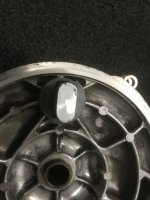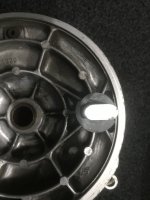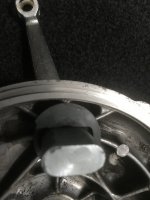Now I'll discuss the component parts. This mainly consists of the camshaft and it's spacer or spacers. The main goal here is to mount the brake shoes spaced out equally on both ends so they sit parallel to the plate .....
On the '70-'73 plate, this was accomplished mainly with the casting but in '74 that changed. The casting height on the inside of the plate on the camshaft end was reduced by about 6mm, most likely to provide room for that electric switch. Along with that, it was extended outward by the same amount on the outside. Basically, the length or depth of the pivot hole through the plate remained the same, it was just shifted farther out .....
But, to keep the shoes mounted square to the plate, the camshaft had to be spaced back in to make up for the 6mm of missing casting. So, a new longer camshaft was needed. The spacer used on it also needed to be rather special. It had to lock onto the camshaft so it would rotate with it and also need a beveled or ramped area on it's bottom to progressively work and activate that electric switch.
So, here's the 3 styles of camshaft Yamaha used. The short one on the left will only work in the early "256" plate. The two newer longer ones will only work in the '74 and later plates .....
Now obviously, that funky spacer Yamaha needed for the electric switch models was difficult and expensive to make. Once they eliminated the switch, they didn't need that anymore. They switched to 2 thick flat washers. Again, this required a camshaft re-design, but Yamaha got their money out of this one. They continued to use it on a multitude of models pretty much right up to the present day. The early camshaft used just one thin shim washer (1/2mm thick) as it's spacing was achieved with the casting .....






